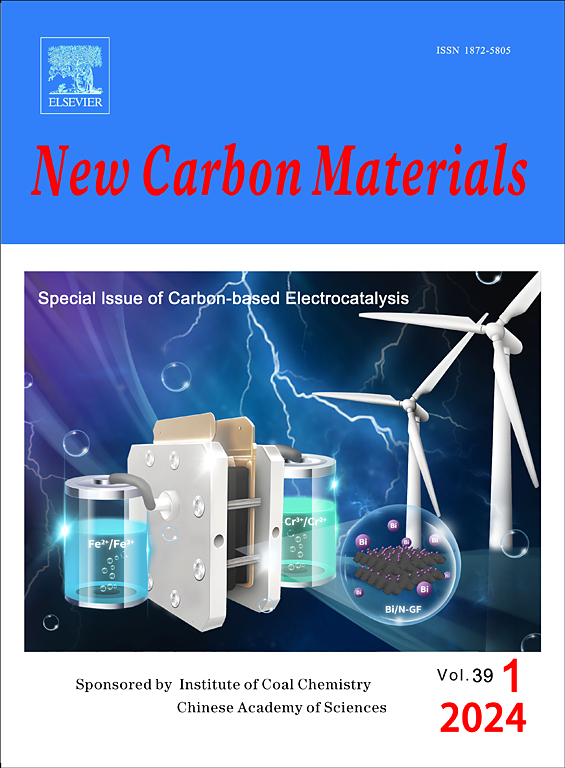A B,N co-doped carbon nanotube array with anchored MnO2 nanosheets as a flexible cathode for aqueous zinc-ion batteries
IF 5.7
3区 材料科学
Q2 Materials Science
引用次数: 0
Abstract
For rechargeable aqueous zinc-ion batteries (ZIBs), the design of nanocomposites comprised of electrochemically active materials and carbon materials with novel structures has great promise in addressing the issue of electrical conductivity and structural stability in the electrode materials during electrochemical cycling. We report the production of a novel flexible electrode material, by anchoring MnO2 nanosheets on a B,N co-doped carbon nanotube array (BNCNTs) grown on carbon cloth (BNCNTs@MnO2), which was fabricated by in-situ pyrolysis and hydrothermal growth. The generated BNCNTs were strongly bonded to the surface of the carbon fibers in the carbon cloth which provides both excellent electron transport and ion diffusion, and improves the stability and durability of the cathode. Importantly, the BNCNTs offer more active sites for the hydrothermal growth of MnO2, ensuring a uniform distribution. Electrochemical tests show that BNCNTs@MnO2 delivers a high specific capacity of 310.7 mAh g−1 at 0.1 A g−1, along with excellent rate capability and outstanding cycling stability, with a 79.7% capacity retention after 8000 cycles at 3 A g−1.
- Download: Download high-res image (181KB)
- Download: Download full-size image
锚定 MnO2 纳米片的 B、N 共掺杂碳纳米管阵列作为水性锌离子电池的柔性阴极
对于可充电水性锌离子电池,由电化学活性材料和结构新颖的碳材料组成的纳米复合材料的设计对于解决电极材料在电化学循环过程中的导电性和结构稳定性问题具有很大的前景。我们报道了一种新型柔性电极材料的生产,通过原位热解和水热生长,将二氧化锰纳米片锚定在生长在碳布(BNCNTs@MnO2)上的B,N共掺杂碳纳米管阵列(BNCNTs)上。生成的BNCNTs在碳布中与碳纤维表面紧密结合,提供了良好的电子传递和离子扩散,提高了阴极的稳定性和耐久性。重要的是,BNCNTs为MnO2的水热生长提供了更多的活性位点,确保了其均匀分布。电化学测试表明,BNCNTs@MnO2在0.1 a g−1下可提供310.7 mAh g−1的高比容量,同时具有出色的倍率能力和出色的循环稳定性,在3a g−1下循环8000次后容量保持率为79.7%。下载:下载高清图片(181KB)下载:下载全尺寸图片
本文章由计算机程序翻译,如有差异,请以英文原文为准。
求助全文
约1分钟内获得全文
求助全文
来源期刊

New Carbon Materials
MATERIALS SCIENCE, MULTIDISCIPLINARY-
CiteScore
6.10
自引率
8.80%
发文量
3245
审稿时长
5.5 months
期刊介绍:
New Carbon Materials is a scholarly journal that publishes original research papers focusing on the physics, chemistry, and technology of organic substances that serve as precursors for creating carbonaceous solids with aromatic or tetrahedral bonding. The scope of materials covered by the journal extends from diamond and graphite to a variety of forms including chars, semicokes, mesophase substances, carbons, carbon fibers, carbynes, fullerenes, and carbon nanotubes. The journal's objective is to showcase the latest research findings and advancements in the areas of formation, structure, properties, behaviors, and technological applications of carbon materials. Additionally, the journal includes papers on the secondary production of new carbon and composite materials, such as carbon-carbon composites, derived from the aforementioned carbons. Research papers on organic substances will be considered for publication only if they have a direct relevance to the resulting carbon materials.
 求助内容:
求助内容: 应助结果提醒方式:
应助结果提醒方式:


